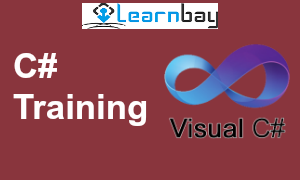Course description
C# is a simple, modern, general-purpose, object-oriented programming language developed by Microsoft within its .NET initiative.This course will help you to learn basic and Advance Concept of C#.
Who Should Attend:
Those who want to become master in C#.
Those whose want to improve his knowledge in C#.
Freshers/Experienced Professional
Course delivery:
Online classes with 60% theory and 40% hands on,Practice ,Assignment.
What will you Learn:
Basics and Advance C# Programming.
Syllabus:
Chapter 1:
Introduction
Components of .NET framework, building blocks. Execution workflow.
Components of .NET framework, building blocks. Execution workflow.
Chapter 2: Varibles And Types
Simple Variables and Type Fundamentals.
Basic in-built data types. Value types & reference types. Similarities and differences.
Chapter 3:Basic C# Types & .NET Framework Types
Boxing-Unboxing, cost associated with them. How to avoid boxing-unboxing to boos performance. Common Type System. CLS.
Instance Properties and Methods-Defining, accessing and modifying the instance properties..NET Framework Static Methods
Chapter 4: Control Flow And Loops
keywords like if/else/else if/switch-case/return/goto and many more.
Loops and Recursion: Keywords like for/while/do-while/for-each etc.
Chapter 5:
Navigating type hierarchies: is/as/cast.
Methods, Fields, Events, and Properties
Primitive, Reference, and Value Types
ByVal , ByRef & Out parameters
Chapter 6:Strings,Arrays And Other Collection
Chars, Strings, and Working with Text – Mutable and immutable types in C#.
Arrays and other Collections: Collection fundamentals.
Nullable types,Enumerated Types and Bit Flags
Chapter 7: Exceptional Handling And Garbage Collection
Exception Handling; Try-catch-finally blocks. System / Application exceptions, user defined exceptions.
Garbage Collection-Finalize / GC.Collect / Distructor etc
Chapter 8: Applets
Configuring applets
Applet capabilities and restrictions
Chapter 9: Object Oriented Programming in C#
Classes and Objects:Defining classes and creating objects. Accessing properties and methods through objects.
Classes having fields and methods
Constructors and initialization – Different kinds of constructors and constructor calling hierarchy. Ways to call a constructor.
Instance and Static members, constructors – this, base keywords. Calling constructors within another constructor.
Acess modifiers – keywords like private, public, internal, protected etc.
Overloading, Overriding, Hiding- Effects of these keywords on Methods, properties, constructors and members.
Abstract, Static, Sealed, Partial Classes
Abstract class as parent class – Defining an abstract base class and Using inheritance to derive a new class.
Sealed and new methods.
Chapter 10: Interface
Defining and implementing an interface- An interface is like an abstract base class. Any class or struct that implements
the interface must implement all its members.
Explicit interface implementation,Mixing interfaces and inheritance
Delegates and Events- A delegate is a C# language element that allows you to reference a method. Events in C# are implemented with delegates
Understanding .NET Framework using C#
Chapter 11: Threads
Synchronization
Chapter 11: MSIL and ILDASM
During the compile time , the compiler convert the source code into Microsoft Intermediate Language (MSIL).
Ildasm.exe shows more than just the Microsoft intermediate language (MSIL) code
Chapter 12: Storage Type
Strong type and weak type- We will see what is the difference between strong typing and weak typing in .NET.
Strong naming and Signing assembly- A strong name consists of the assembly’s identity—its simple text name,
version number, and culture information
Chapter 13: Assembly Loading and Reflection
By using Reflection in C#, one is able to find out details of an object, method,
and create objects and invoke methods at runtime.
Delay signing of assemblies-Delay signing as the name suggest is delaying in signing of assembly in order to make written code secure even from the internal developers.
Chapter 14: JIT compilation and NGEN Tool
The JIT compiler translates the MSIL code of an assembly to native code and uses the CPU architecture of the target machine to execute a .NET application.
Chapter 15:Run time Serialization
System. Run-time. Serialization namespace contains classes that can be used for serializing and deserializing objects.
Serialization is the process of converting an object or a graph of objects into a linear sequence of bytes
Chapter 16:CLR Hosting and App Domains
App Domain is both a container and a boundary. The .NET runtime uses an AppDomain as a container for code and data,
just like the operating system uses a process as a container for code and data
Chapter 17:ADO.NET using C#
ADO.NET Architecture,Connection, Command objects in ADO.NET
Data reader and Data set objects.-Accesing data using Data reader and Data-set objects.Manipulating data.
Connection Pooling,Transactions in ADO.NET
Advanced C# Topics
Chapter 18:Generics
Introduction to generic Methods,Class, Collection, constraints and data types.
Chapter 19: List, Dictionary, Hashtable, Stack, Queue etc.
C# data structures, differences and implementation.Named parameters, Extension Methods
Var and Dynamic keywords,Static types and dynamic types in C#
Chapter 20:Linq Fundamentals and Lambda Expressions
Language Integrated Query offers easy data access from in-memory objects, databases, XML documents and many more.
Chapter 21: Threading And Asynchronous Programming
Threading basics: Using threads with C# application. Different ways that we can use threads .net framework applications.
Asynchronous Programming using C#



Abhisek – :
.